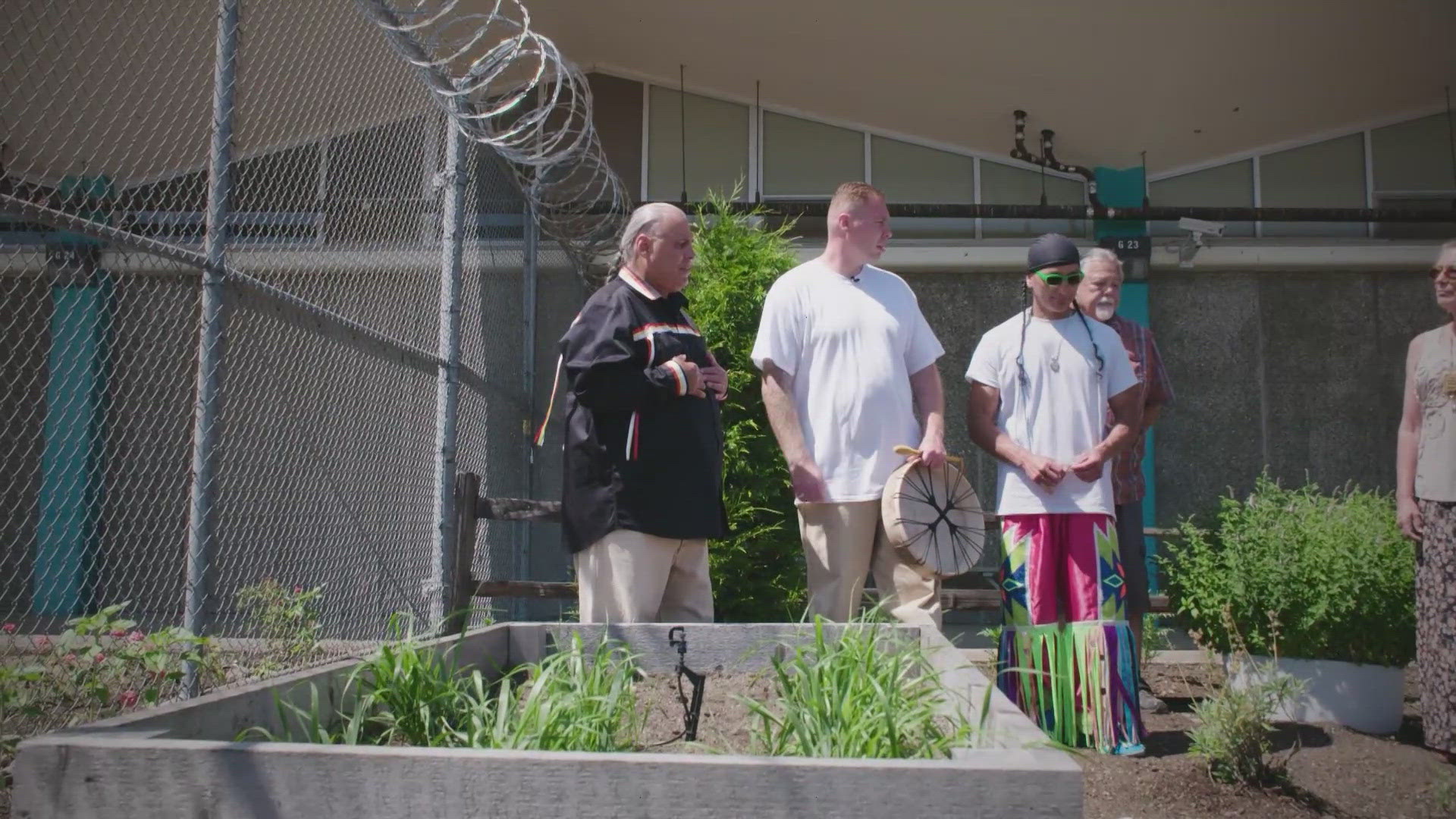SHELTON, Wash. — Barbed wire and concrete walls at the Washington Corrections Center (WCC) don't keep culture out. In fact, at the Shelton correctional facility, and also at several other DOC buildings, Indigenous inmates enjoy powwows and other ways to connect with their roots.
"Our brothers find healing right here, especially here on the inside where it's most needed," Charles Longshore said. Longshore was running his hands through freshly picked lavender from WCC's new Medicine Garden.
More than a decade in prison has turned Charles Longshore into someone who appreciates the small things in life.
"You can already tell how many leaves he's got - he's going to be big," Longshore said with a proud grin on his face, touching a young sage plant. "That guy, he's real special."
Longshore is serving a 36-year sentence for killing two people over a drug debt. Twelve years into his sentence, Longshore said he's had time to look back on his violent actions.
This year, he testified to members of the Washington State legislature, in support of a bill that would modify criminal sentences on a case-by-case basis.
" I have reconciled all broken relationships, I've taken responsibility for my actions, and I've heard the words 'I forgive you' by survivors in my case," he said via Zoom in front a judiciary committee. "I am rehabilitated."
Longshore said the medicine garden played a big role in that rehabilitation.
"Right away a crew of us came out here on a Friday and went to work," he said. "Just started pulling every weed we can, rototilling up, and cleaning this all out and building it up from there."
He explained the plot of land the garden sits on now was overgrown with weeds and had rocks everywhere. With huge effort from him and other inmates, they were able to establish what it is today-- a healing space.
It's also one tool that helps Indigenous inmates at Shelton feel grounded.
Most importantly, it is a spiritual space, where Indigenous prisoners can cultivate plants, just like their ancestors did for thousands of years. The barbed wire is a stark contrast to the soft pastels of culturally significant herbs like lavender and sage.
Many are used to bless and cleanse in ceremonies. Some are used to treat illnesses. From time immemorial, these plants have been a cornerstone of Indigenous life.
"That cedar for us, Coast Salish, that's our cleansing," Longshore said, pointing to a cedar tree in the corner. "Some of us will put that on our door, some of that will hang up so it brushes you off when you walk in. It takes anything off of you."
Working on the garden is also a sensory experience.
"Right now I feel like it's cleaning me, I feel like it's cleansing me, as I pick, I feel like my prayers are being answered, and I know my brothers feel the same way when they come out here and start doing this," Longshore said, a handful of lavender by his nose.
Simply referred to as "the medicine," these herbs heal wounds of all kinds. The garden itself is a reminder of culture, identity and routine.
"We all come from intergenerational trauma, we come from different places of life, our people have faced genocide, our people have endured a different kind of struggle here, dating back to the colonization of America," Longshore explained. "So when an Indian comes in here, our goal is to help them get out better than they were when they came in."
For Native American inmates, the recidivism rate is 45.3%, meaning nearly half of Indigenous inmates released from the Department of Corrections will come back within 36 months. In contrast, the overall recidivism rate is 22% for all inmates.
Gabe Galanda has been trying to bridge that disparity. Galanda, an enrolled member of the Round Valley Indian Tribes in California, is a lawyer and the founder of Huy, a nonprofit that advocates for tribal members in prison.
The group works to get Indigenous inmates access to powwows and medicine gardens.
"You have an absolute right to use religion and spirituality as a mode of healing," Galanda said.
In terms of how culturally relevant activities impact recidivism?
"It's focusing our folks who have fallen down on themselves, in a way maybe they never knew, or in a way they are now reacclimating to, and it causes them to have to reconcile with the mistakes they made, maybe their hurt or trauma they've caused," Galanda explained. "Ultimately the hurt and trauma that was within them that probably led to the trauma for someone else. Through that process, there's medicine and healing, and we think that is the best possible means for reentry and avoiding recidivism."
Back at the Shelton Medicine Garden, Charles Longshore's ongoing work of reconciling with his violent past continues.
"For me, it's about maintaining my identity as an Indian man, to be able to be connected to my spirituality is key to my rehabilitation," Longshore said. "To be with the medicine, to be with our people, to be with the song, and ceremony, to be with this garden, it's me being Indian."
And when the Indigenous and imprisoned connect to their roots, they're able to find the space to grow
"This is harmony, this is peace, this is serenity," Longshore said. "This is healing, this is restoration, this is rehabilitation."
Of the 21 DOC facilities around the state, right now 10 of them have medicine gardens.

